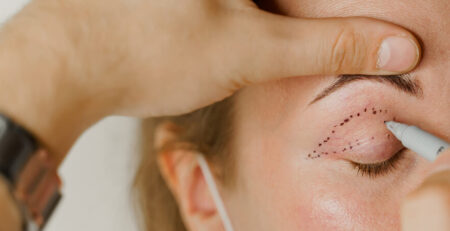Is Blepharoplasty Surgery Safe?
As age advances, many people look for remedies to the sagging skin around the eyes, making them look even older. There are cosmetic remedies available; however, not many prove to be effective, and some take months to show the initial results.
So what is the quick, effective and long-lasting remedy to this problem?
There is a surgery to minimise sagging, or puffiness of the upper or lower eyelids called eyelid surgery. Medically known as blepharoplasty, this surgery is commonly performed for aesthetic reasons. However, it may become medically imperative if the sagging skin blocks vision.
While the eyelid skin stretches, the underlying muscles may weaken, and fat build above or below the eyes. Bags beneath the eyes, sagging eyelids and eyebrows, and extra skin around the eyes are possible outcomes. It might also cause puffiness in your eyes. Blepharoplasty surgery in Delhi, tightens the muscles and removes extra fat from around the eyes. It can be performed on either the upper or lower eyelids.
The success of the surgery majorly depends on the facility and the surgeon you choose.
Let’s know better before we make a decision.
Is eyelid surgery safe?
Blepharoplasty, or eyelid surgery, is a popular surgery and is one of the safest cosmetic operations.
Eyelid surgery or blepharoplasty, like any other surgical operation, carries usual risks. If we are not in safe hands, the risks can only increase. A qualified surgeon minimises the risks while enhancing the results manifolds.
Blepharoplasty is often performed as an outpatient operation, and patients may have some swelling and bruising in the days following surgery. These symptoms are generally minor and go away on their own. Always choose an experienced cosmetic surgeon with a nuanced skillset to avoid these problems.
Initial Steps
Making an informed decision is the first and most significant stage in every cosmetic surgery procedure. Some patients may have underlying medical conditions that increase the surgery risk. Before undergoing blepharoplasty, you should discuss them with your surgeon and how they may raise your risk of certain negative consequences. Your pre-surgical consultation should include determining your risks and comparing them against potential advantages.
Your surgeon will recommend discontinuing certain medications and making lifestyle changes like giving up on smoking for a smoother and uncomplicated recovery. To follow all the presurgery and post-op care recommendations that your surgeon gives is crucial.
When choosing the surgeon and centre for your blepharoplasty, prioritise quality and your safety over cost. In blepharoplasty or any cosmetic surgery, it’s always important to get the results right the first time, and corrective surgeries further complicate the entire process while compromising your safety.
How to prepare for safer outcomes?
To prepare for eye-lift/blepharoplasty surgery, you must first meet with a plastic surgeon to discuss your reasons for choosing the treatment, your concerns, and your projected outcomes. The surgeon will need you to undertake several tests to understand your medical and physical condition better. Your eyes and the surrounding region are checked as part of the physical examination. You may be asked for eyesight and tear tests. The surgeon will photograph the region for reference and medical information.
Blepharoplasty is performed as an outpatient procedure, and patients can return home after a few hours. In certain circumstances, general anaesthesia is used for surgery, whereas in most cases, just a local anaesthetic or numbing medication is used for the surgery. The incisions used in blepharoplasty are performed so that the scars are nicely hidden within the natural creases of the eye area. The incisions are sutured. Within a week of operation, the sutures are removed.
How safe is the recovery period for eyelid or blepharoplasty surgery?
The surgery has a quick recovery time than other cosmetic treatments. After being monitored for any post operative effects, you’ll be discharged a few hours after the treatment. After the procedure, you will be advised to rest for a few days and will be prescribed drugs to help with swelling and discomfort. In most cases, these symptoms will go completely in a week or two.
After the eye-lift operation, the surgeon will instruct you not to wear contact lenses for the coming few weeks. You should use only water or light soap to clean the operated area, and it must be maintained clean and hygienic.
Consecutive visits at regular intervals are advised for about a period of 3-4 weeks.
Dr Lokesh Handa performs blepharoplasty surgery with state-of-the-art technology and the most up-to-date techniques to improve natural-looking outcomes. His years of experience assure that he conducts painless and scar-free blepharoplasty surgery, resulting in a comfortable recovery and stunning results.











